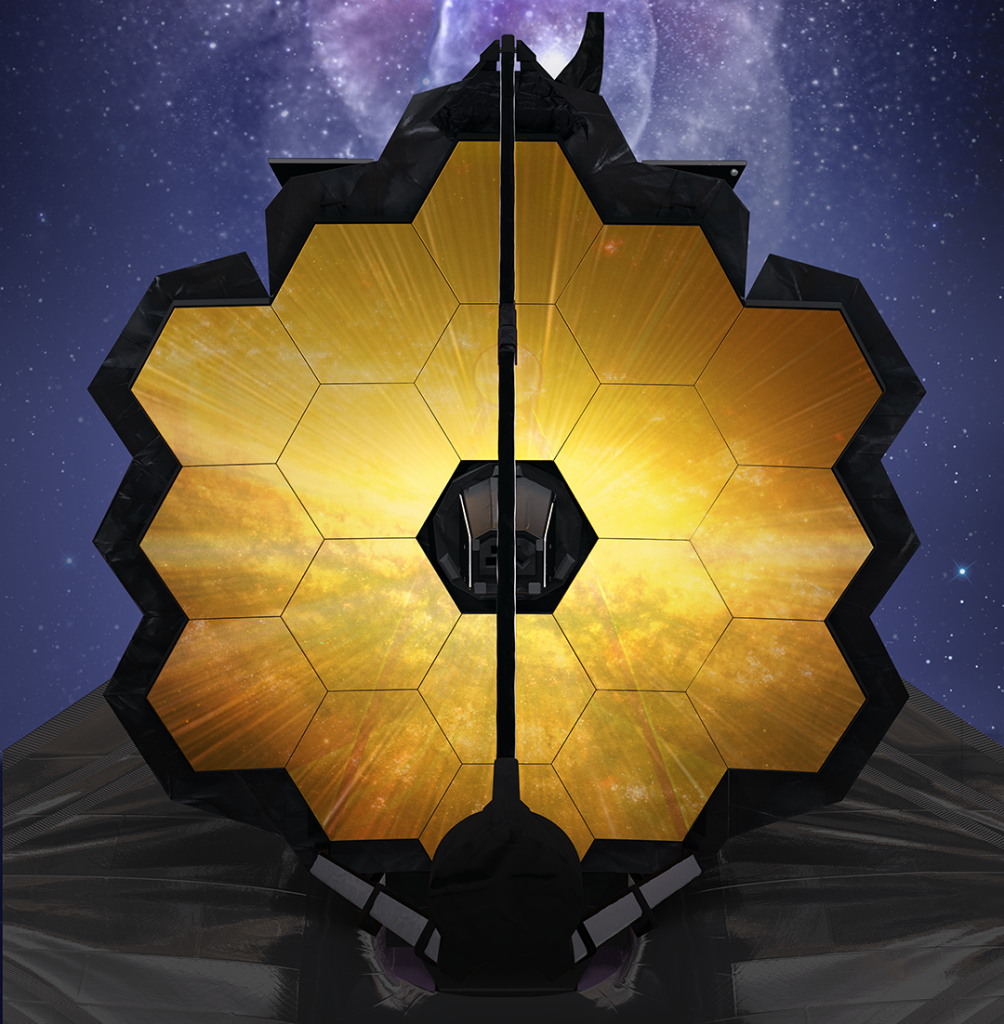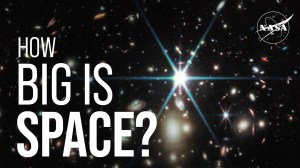


Webb Telescope Latest News
Webb's latest news blog releases in reverse chronological.
Webb Social Media (offsite) : X | Instagram | Facebook | Youtube | Flickr
Latest Webb News
Search and sort the news feed with the controls immediately below.
Filters

Since July 2022, NASA’s James Webb Space Telescope has been unwaveringly focused on our universe. With its unprecedented power to detect and analyze otherwise invisible infrared light, Webb is making observations that were once impossible, changing our view of the…

NASA’s James Webb Space Telescope recently zeroed in on the Bullet Cluster — delivering highly detailed images that show a greater abundance of extremely faint and distant galaxies than ever before. Using Webb’s crisp near-infrared observations of this region, researchers…

Astrophysics Science Video Producer – Goddard Space Flight Center Growing up in Detroit with a camera in her hand, Sophia Roberts — now an award-winning astrophysics science video producer—never imagined that one day her path would wind through clean rooms,…

Present-day disk galaxies often contain a thick, star-filled outer disk and an embedded thin disk of stars. For instance, our own Milky Way galaxy’s thick disk is approximately 3,000 light-years in height, and its thin disk is roughly 1,000 light-years…

Astronomers using NASA’s James Webb Space Telescope have captured compelling evidence of a planet with a mass similar to Saturn orbiting the young nearby star TWA 7. If confirmed, this would represent Webb’s first direct image discovery of a planet,…

What does it take to gaze through time to our universe’s very first stars and galaxies? NASA answers this question in its new documentary, “Cosmic Dawn: The Untold Story of the James Webb Space Telescope.” The agency’s original documentary,…

Astronomers using data from NASA’s James Webb Space Telescope have identified dozens of small galaxies that played a starring role in a cosmic makeover that transformed the early universe into the one we know today. “When it comes to producing…

A planetary system described as abnormal, chaotic, and strange by researchers has come into clearer view with NASA’s James Webb Space Telescope. Using Webb’s NIRCam (Near-Infrared Camera), researchers have successfully imaged one of two known planets surrounding the star 14…

Video Producer – Goddard Space Flight Center What sparked your interest in video production, and what drew you to NASA? Ever since I saw “Star Wars” at nine years old, I knew I wanted to make movies. I would make…

Black holes are invisible to us unless they interact with something else. Some continuously eat gas and dust, and appear to glow brightly over time as matter falls in. But other black holes secretly lie in wait for years until…

After capturing an image of the iconic Sombrero galaxy at mid-infrared wavelengths in late 2024, NASA’s James Webb Space Telescope has now followed up with an observation in the near-infrared. In the newest image, the Sombrero galaxy’s huge bulge, the…

How big is space? Space is really big. Thinking about our solar system, let’s imagine you could get in a car and drive to Pluto at highway speeds. It would take you about 6,000 years to get there. When we…

Is frozen water scattered in systems around other stars? Astronomers have long expected it is, partially based on previous detections of its gaseous form, water vapor, and its presence in our own solar system. Now there is definitive evidence: Researchers…

Saturn’s moon Titan is an intriguing world cloaked in a yellowish, smoggy haze. Similar to Earth, the atmosphere is mostly nitrogen and has weather, including clouds and rain. Unlike Earth, whose weather is driven by evaporating and condensing water, frigid…

NASA’s James Webb Space Telescope has captured new details of the auroras on our solar system’s largest planet. The dancing lights observed on Jupiter are hundreds of times brighter than those seen on Earth. With Webb’s advanced sensitivity, astronomers have…

In July 2022, NASA’s James Webb Space Telescope made its public debut with a series of breathtaking images. Among them was an ethereal landscape nicknamed the Cosmic Cliffs. This glittering realm of star birth is the subject of a new…

Though they don’t orbit around our Sun, sub-Neptunes are the most common type of exoplanet, or planet outside our solar system, that have been observed in our galaxy. These small, gassy planets are shrouded in mystery…and often, a lot of…

NASA needs your help identifying the shapes of thousands of galaxies in images taken by our James Webb Space Telescope with the Galaxy Zoo project. These classifications will help scientists answer questions about how the shapes of galaxies have changed…

How are we made of star stuff? Well, the important thing to understand about this question is that it’s not an analogy, it’s literally true. The elements in our bodies, the elements that make up our bones, the trees we…

Gas and dust ejected by a dying star at the heart of NGC 1514 came into complete focus thanks to mid-infrared data from NASA’s James Webb Space Telescope. Its rings, which are only detected in infrared light, now look like…
Latest Webb Blogs
Webb's Blog offers an insider's point of view covering a variety of topics that include on going operations as well as exciting Webb science images/spectra that are not yet peer reviewed and therefore not released as NASA feature articles ( IE the above official Webb News Feed). Blog posts are often co-authored by scientists and engineers and offer unique insights. <strong>Search and sort the news feed with the controls immediately below.</strong>
Filters

While asteroid 2024 YR4 is currently too distant to detect with telescopes from Earth, NASA’s James Webb Space Telescope collected one more observation of the asteroid before it escaped from view in its orbit around the Sun. With the additional data,…

This artist’s concept shows what exoplanet K2-18 b could look like based on science data. K2-18 b, an exoplanet 8.6 times as massive as Earth, orbits the cool dwarf star K2-18 in the habitable zone and lies 120 light-years from…

Editor’s Note: This post highlights data from Webb science in progress, which has not yet been through the peer-review process. These results were reported as part of NASA’s role in the International Asteroid Warning Network. NASA’s James Webb Space Telescope recently…

Trans-Neptunian objects (TNOs) are icy bodies ranging in size from Pluto and Eris (dwarf planets with diameters of about 1,500 miles) down to tens of miles (Arrokoth) and even smaller. TNOs are on orbits comparable in size, or even much…

NASA’s James Webb Space Telescope is the largest and most powerful telescope ever launched to space. Its mirror is composed of 18 individual segments that have been aligned so accurately, that they effectively work as a single giant (21.6-foot, or…

Editor’s Note: This post highlights data from Webb science in progress, which has not yet been through the peer-review process. Measuring the Hubble constant, the rate at which the universe is expanding, is an active area of research among astronomers around…

Exoplanets are common in our galaxy, and some even orbit in the so-called habitable zone of their star. NASA’s James Webb Space Telescope has been busy observing a few of these small, potentially habitable planets, and astronomers are now hard…

Editor’s Note: This post highlights data from Webb science in progress, which has not yet been through the peer-review process. Over the last two years, scientists have used NASA’s James Webb Space Telescope (also called Webb or JWST) to explore…

NASA's James Webb Space Telescope is delivering on its promise to explore the farthest reaches of the universe, looking back to a time when galaxies were just beginning to form. Scientists have been eagerly waiting to use this complex observatory…

Editor's Note: This post highlights data from Webb science in progress, which has not yet been through the peer-review process. In November 2023, NASA's James Webb Space Telescope observed a massive cluster of galaxies named MACS J0138.0-2155. Through an effect…

One of NASA's James Webb Space Telescope's science goals is to understand how galaxies in the early universe formed and evolved into much larger galaxies like our own Milky Way. This goal requires that we identify samples of galaxies at…

NASA's James Webb Space Telescope observed the exoplanet WASP-80 b as it passed in front of and behind its host star, revealing spectra indicative of an atmosphere containing methane gas and water vapor. While water vapor has been detected in…

The rate at which the universe is expanding, known as the Hubble constant, is one of the fundamental parameters for understanding the evolution and ultimate fate of the cosmos. However, a persistent difference called the "Hubble Tension" is seen between…

On Apr. 21, 2023, the James Webb Space Telescope team shared that one of the MIRI (Mid-Infrared Instrument) observing modes, called Medium-Resolution Spectroscopy (MRS), showed a reduction in the amount of light registered by MIRI's detectors. Initial analysis of MIRI's…

Editor's Note: This post highlights data from Webb science in progress, which has not yet been through the peer-review process. NASA's James Webb Space Telescope obtained images of the Ring Nebula, one of the best-known examples of a planetary nebula.…

NASA's James Webb Space Telescope is nearly 1 million miles (1.5 million kilometer) away from Earth, orbiting around the Sun-Earth Lagrange point 2. How do we send commands and receive telemetry – the science and engineering data from the observatory…

July 12 marks the first anniversary of science and amazing discoveries from NASA's James Webb Space Telescope. To celebrate the year of spectacular discoveries, on July 12, 14 and throughout the summer, there will be multiple events online and live…

Editor's Note: This post highlights data from Webb science in progress, which has not yet been through the peer-review process. On June 25, 2023, NASA's James Webb Space Telescope turned to famed ringed world Saturn for its first near-infrared observations…

This week, astronomers around the world are celebrating the announcement of the next cycle of Webb observations. We asked Christine Chen, associate astronomer and JWST Science Policies Group lead at the Space Telescope Science Institute, to describe the selection process…

All 17 observing modes of the James Webb Space Telescope undergo routine performance monitoring and calibration. This month, while performing calibration by comparing the brightness of standard stars that have been well-cataloged by other observatories to what Webb's Mid-Infrared Instrument…
What is Webb Observing?
See current, upcoming and recent past observations scientists are making with the Webb Space Telescope. View details about each observation's science focus areas, the instruments used and more.
View the Tool


























